Administrator: David Cowall Contact
Science Advisor: Arne Henden
System Software Advisors: George Silvis, Cliff Kotnik
System Technical Advisor: Ken Menzies
Systems Engineering: Gary Walker
Business Development: Richard Post
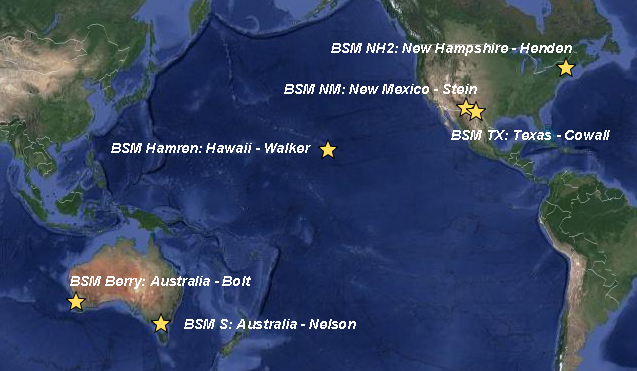
The Bright Star Monitors (BSM) are a subset of the AAVSOnet. They offer members an opportunity to do CMOS and/or CCD multi-filter observing of stars from 0 to 16 in Vmag with small, robotically controlled telescopes that are located from New Hampshire to Australia. An additional benefit is that it gives dark sky and clear weather to member who might not have that from their location. It also provides robotic observations when one has other engagements and is not able to observe from their telescope. Images are automatically calibrated and then provided to the users for analysis. The AAVSOnet Forum is available for questions, comments, and suggestions.
Interested in joining this section? Click here for instructions.
Watch the BSM Section webinar (recorded June 27, 2020).
BSM History
When the unusual eclipsing binary ε Aurigae approached its 27.1-year primary eclipse in 2008, none of the telescopes accessible to the AAVSO were capable of obtaining photometry on such a bright object. We also realized that this was not an isolated case; there are hundreds of bright variables that are being overlooked by professionals and amateurs alike. Every current survey saturates on the bright stars. The one survey that comes closest is the wide-field cameras of the All-Sky Automated Survey (ASAS), which saturates at mag 10 and has a limiting mag of 17. The visual observers have been doing an excellent job of following the bright long-period variables, like Mira and R Sct, but all of the bright low-amplitude variables, such as the naked-eye Cepheids and Algol are not being followed with high precision.
As a pilot project, the Council decided in 2008 to create a simple, inexpensive BSM system consisting of a 60mm refractor, GOTO mount, BVRI filters, CCD camera, and commercial software (all funded by Council members). In 2009 the AAVSO received an NSF Citizen Science grant to study the upcoming minimum of ε Aurigae. In April, 2009 the initial BSM was installed at the Astrokolhoz Observatory at Cloudcroft, NM (see below).


ε Aurigae began to fade in August of 2009 and the BSM observations beginning in September are indicated by the large blue plus signs on the flat bottom of the BVRI light curves shown below:

Setting up this original system was an exercise in scrounging. Several people (including Jim Bedient, Doug Welch and Donn Starkey) made donations to pay for much of the equipment. SBIG donated the ST-8XME and filter wheel as part of their corporate sponsorship of the AAVSO. Doug George of Cyanogen contributed MaximDL. Bob Denny of DC3 Dreams contributed ACP and ACP Scheduler.
Based upon this pilot experience, it was decided to expand the system to multiple sites worldwide using similar equipment and offer use of the system to AAVSO members as a benefit. Several years of experience with this network has shown that precision, bright star photometry is possible using small telescopes, even in bright, urban environments. Many bright variables got their first BVRI light curves. Comparison stars for bright targets were developed and the platform served as a testbed for hardware and software. Many member projects contributed to the AAVSO International Database (AID) and resulted in multiple scientific publications.
However, it became apparent that the mounts were not sufficiently robust for long-term robotic operation. The small OTA apertures caused scintillation during short exposures and some cameras reached the ends of their useful lives as CCD sensors became less available and often replaced by CMOS technology. Fortunately, Richard Post was able to obtain mounts and OTAs on long-term loan from The Tzec Maun Foundation and contributions for new CMOS cameras came from the membership. After thorough testing at the New Hampshire site, new systems also came on-line in New Mexico, Hawaii, and on the east and west coasts of Australia. The image below is of the New Mexico instrument:
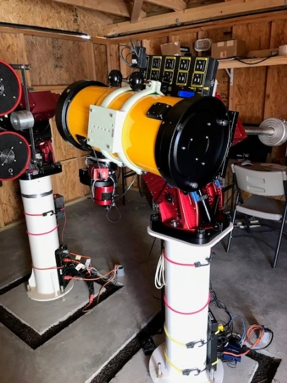
- Takashi E-180 f 2.8 astrograph
- Software Bisque Paramount ME mount
- ZWO ASI183mm-pro camera
- ZWO EFW-8 filter wheel
- ZWO EAF focuser
- 8 filters (B, V, R, I, SU, SG, SR, SI)
- 2 arcsec Resolution with 2X2 binning
The newest of the BSMs (BSM_TX) came online in May of 2020 at the Dark Sky Observatory in West Texas (see below):
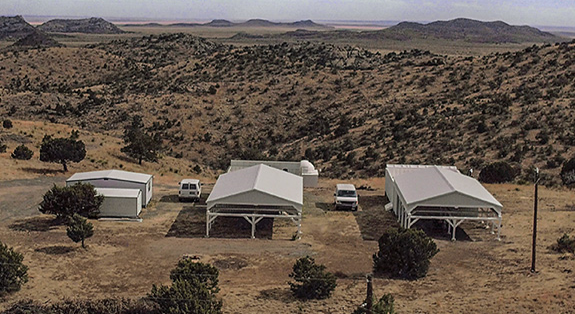
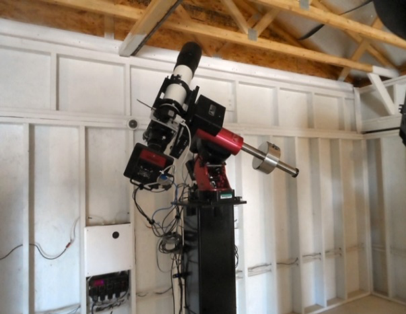
- Televue NP101 f 5.4 Refractor
- Software Bisque Paramount MYT mount
- SBIG STF-8300 CCD Camera
- SBIG FW-8 filter wheel
- MoonLite CFL-2.5-inch focuser
- 8 filters (B, V, R, I, SU, SG, SR, SI)
- 2 arcsec Resolution with 1X1 binning
How to use the Bright Star Monitor Network
Request telescope time:
To be assigned telescope time, an AAVSO member simply provides a brief description of the project and the appropriate target information, using the following form, to the Telescope Allocation Committee (TAC).
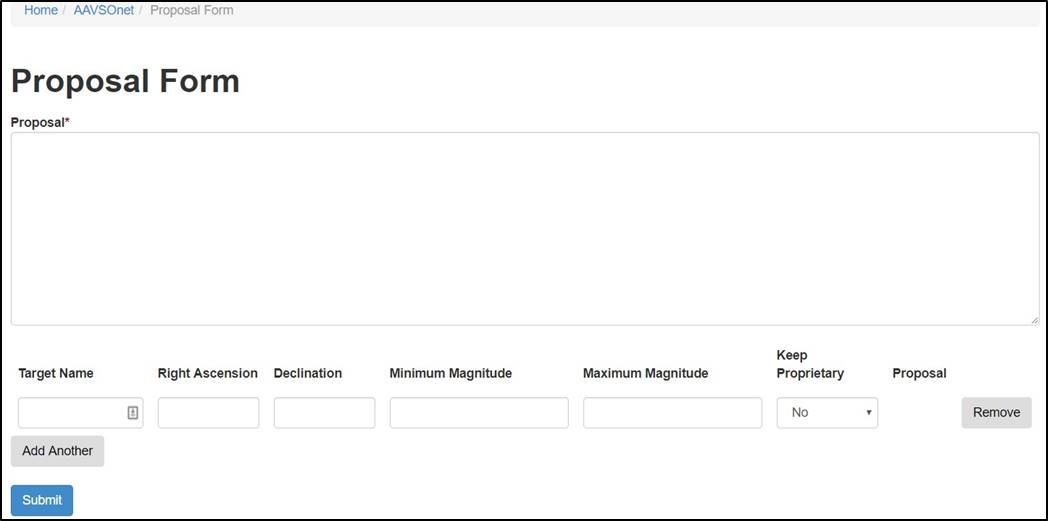
- Observe scientifically important and under-observed bright variable stars
- Support AAVSO Alerts/Campaigns that need more CCD observations
- Provide for member’s stated educational objectives that can be appropriately supported by the BSM Section resources
- Support AAVSO Outreach objectives
Input for the proposal:
- Member Name and Observer Code
- Summary of why the observations of each Target is important scientifically or educationally useful to the member
- User’s plan for the data, i.e. submit to the AAVSO International Database, journal article, education, outreach, etc.
- Request images be sent to VPHOT (free to members)
- Check Variable Star Index:
- Target(s) name verification to ensure name is listed.
- Target Sky Coordinates (J2000)
- Target V magnitude range
- Appropriate comparison stars with standard photometry. The imaging field is similar to a C chart scale (BSM Field of View is about 2 degrees). Request Comparison stars if none exist.
- Time interval for observations in days
- To determine cadence, use the following relationship: dt > (period / dmag) * e, where dt is the cadence (minimum number of days between observations), dmag, the given magnitude difference, and e, the error in one's observations. Then, for any given star of known (even if only approximately) period and range, and a given observer's average error (BSM: use 0.02) a reasonable cadence can be calculated.
- Example: Period = 214, Vmag range = 12.4 to 10.4, the suggested cadence is two days after truncating.
- Filters needed in the session sequence
- Number of images to be taken in each filter
- Exposure time in seconds for each filter
- In general, first determine the V magnitude exposure necessary for your required Signal to Noise Ratio and then follow this ratio: B=2V, R=0.8V, and I=0.7V. Red and Blue targets will alter this rule-of-thumb.
- The BSM telescopes operated unguided. At this time, we typically limit exposures to no more than 80 seconds.
- Start and finish date for the Project
How to get help
If you need help with your proposal, the BSM Section Leader is available through email to answer your questions. Written questions can be also submitted via the AAVSOnet Forum. Another resource is the AAVSO mentor program which is primarily designed to pair new observers with experienced members who can teach them about observing techniques, tools, and methods, but can also be a resource for advice on target selection and interesting projects in support of educational objectives. Finally, if you are a member new to photometry, there are AAVSO CHOICE Courses that are available to augment your understanding of CCD observing and photometric analysis.
Receiving Images
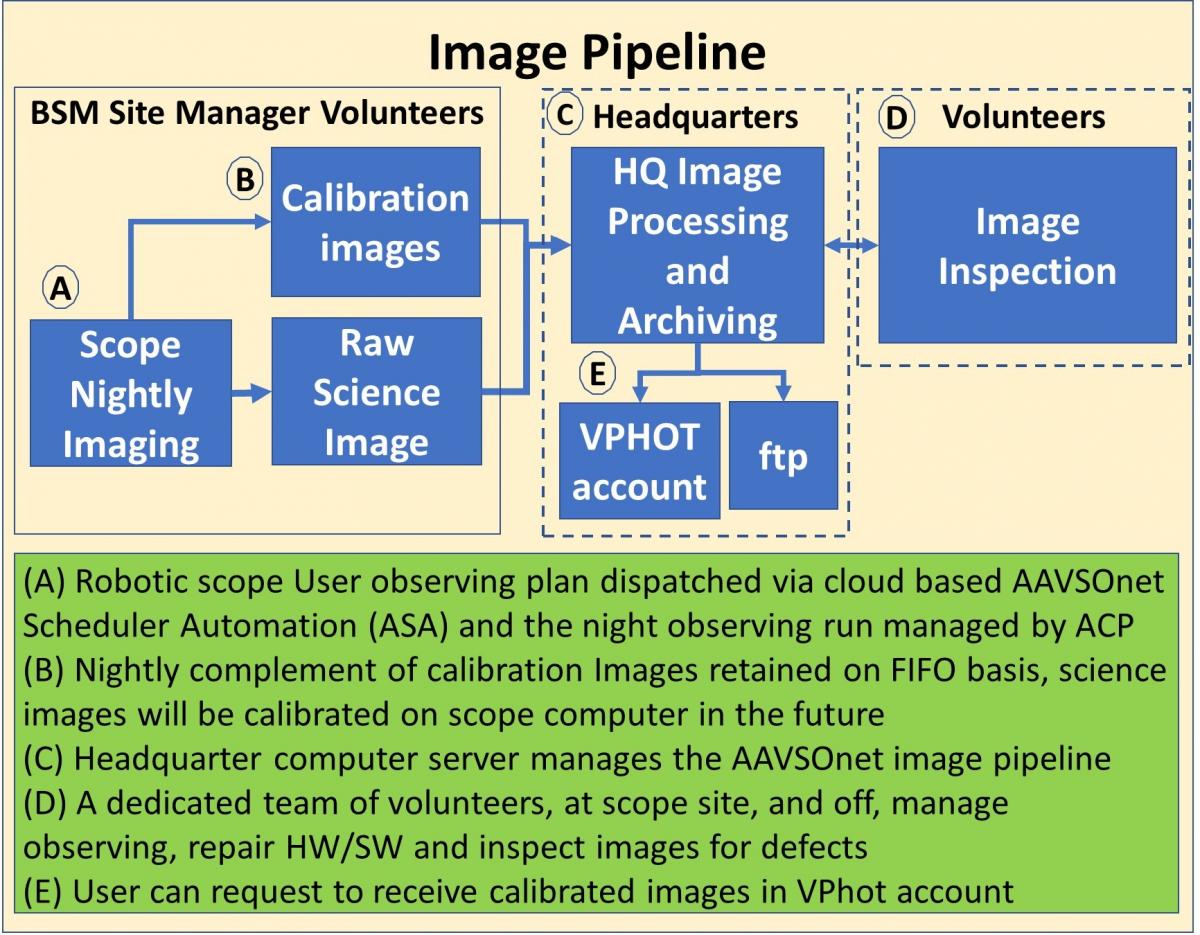
Image Processing
Images can be found here:
Compressed fits images by obscode
Images can also be sent directly to a member’s AAVSO VPhot account:
- VPhot is free, easy-to-use, on-line photometry analysis software for use by members. In addition to the application there is a users guide available
- Measurement results are easily submitted to the AAVSO International Database
- VPhot can provide a two-filter transformation with appropriate BSM site coefficients. It can also support multi-filter and time series transformations generated with the AAVSO TransformApplier application
- An AAVSO VPhot CHOICE Course is available to members
BSM Legacy Targets for Adoption
The BSM Section is requesting members consider performing the observer function for several bright star targets already part of the legacy AAVSO Monitoring Survey. These targets are moving to the latest BSM Section approval protocol.
The AAVSO_Monitoring Survey is a catchall project, containing generally transient objects like PNV_J183657, campaign targets like EE_Cep or b_Per, or just targets where we've been monitoring the field for a long time and continue to do so.
We ask that the adopter write a brief proposal for the Telescope Allocation Committee, perform the photometric analysis and submit the data to the AAVSO International Database. The images will be available through your VPhot account. A list of current targets is provided in the table below.
|
BSM SurveyTarget |
Adopter Obscode | Date Assigned |
| BL_Tel | WEY | 01-15-19 |
| FY_Lib | WEY | 01-13-19 |
| R_Sct | MSD | 01-14-19 |
| U_Mon | DKS | 01-16-19 |
| S_Dor | YPFA | 01-14-19 |
| EE_Cep | DDJ | 01-19-19 |
| EU_Del | DDJ | 01-24-19 |
| GO_Cnc | CCHD | 01-21-19 |
| R_CrB | SPP | 01-21-19 |
| RR_Lyr | DDJ | 01-27-19 |
Also, see the Input for the Proposal paragraph to find out what is needed for submitting the proposal. Remember that the filters, exposures, etc. for these stars have already been determined and don’t need to be identified. For the science statement, you can indicate that you are responding to this BSM Section request for these legacy AAVSO Monitoring Survey stars. Please indicate your interest in an available target by posting a message in the AAVSOnet Forum. Look for an updated table as other targets are added.
Volunteers keeping the BSM Network running

Key Member Volunteers
George Silvis developed and maintains the AAVSO Scheduler Automation (ASA) software which is used to dispatch plans to the BSM sites with help from Cliff Kotnik.
A special thanks to Dick Post and the BSM Section Working Group for their contributions to the formation of the BSM Section:
- Helmar Adler
- Richard Berry
- Cliff Kotnik
- Arne Henden
- Kenneth Menzies
- Gordon Myers
- Mike Nicholas
- Richard Sabo
- George Silvis
- Gary Walker
AAVSO expresses its sincere thanks to the following sponsors for discounts, donations and long-term loan of equipment and software>
- DC3 Dreams
- Diffraction Ltd
- QSI Corp
- Software Bisque
- Tzec Maun Foundation
- Pierre de Ponthiere (LesveDome)
- Steve Beckwith
- Astrodon
- MoonLite
- Moonglow


